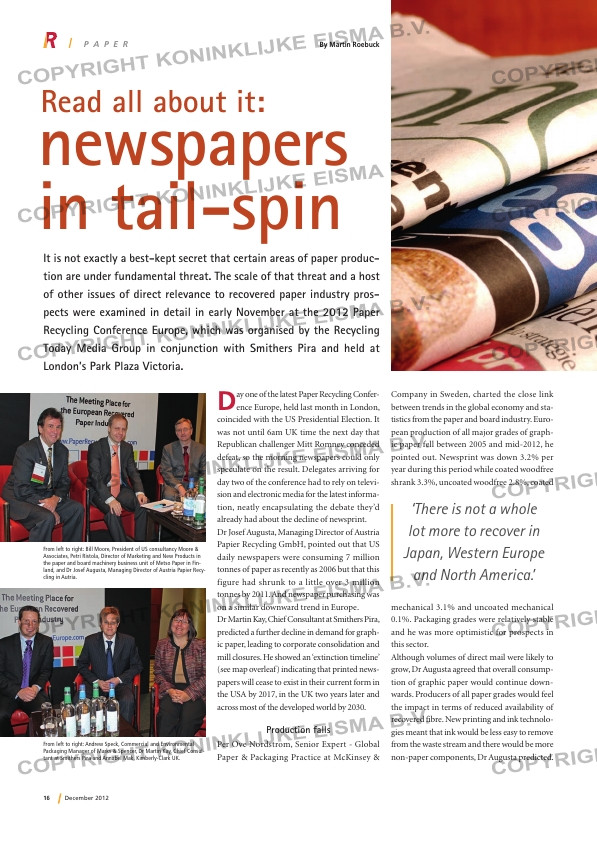Page 16 from: December 2012

16 December 2012
newspapers
in tail-spin
Day one of the latest Paper Recycling Confer-ence Europe, held last month in London,
coincided with the US Presidential Election. It
was not until 6am UK time the next day that
Republican challenger Mitt Romney conceded
defeat, so the morning newspapers could only
speculate on the result. Delegates arriving for
day two of the conference had to rely on televi-
sion and electronic media for the latest informa-
tion, neatly encapsulating the debate they’d
already had about the decline of newsprint.
Dr Josef Augusta, Managing Director of Austria
Papier Recycling GmbH, pointed out that US
daily newspapers were consuming 7 million
tonnes of paper as recently as 2006 but that this
figure had shrunk to a little over 3 million
tonnes by 2011. And newspaper purchasing was
on a similar downward trend in Europe.
Dr Martin Kay, Chief Consultant at Smithers Pira,
predicted a further decline in demand for graph-
ic paper, leading to corporate consolidation and
mill closures. He showed an ‘extinction timeline’
(see map overleaf) indicating that printed news-
papers will cease to exist in their current form in
the USA by 2017, in the UK two years later and
across most of the developed world by 2030.
Production falls
Per Ove Nordstrom, Senior Expert – Global
Paper & Packaging Practice at McKinsey &
Company in Sweden, charted the close link
between trends in the global economy and sta-
tistics from the paper and board industry. Euro-
pean production of all major grades of graph-
ic paper fell between 2005 and mid-2012, he
pointed out. Newsprint was down 3.2% per
year during this period while coated woodfree
shrank 3.3%, uncoated woodfree 2.8%, coated
mechanical 3.1% and uncoated mechanical
0.1%. Packaging grades were relatively stable
and he was more optimistic for prospects in
this sector.
Although volumes of direct mail were likely to
grow, Dr Augusta agreed that overall consump-
tion of graphic paper would continue down-
wards. Producers of all paper grades would feel
the impact in terms of reduced availability of
recovered fibre. New printing and ink technolo-
gies meant that ink would be less easy to remove
from the waste stream and there would be more
non-paper components, Dr Augusta predicted.
p a p e r
It is not exactly a best-kept secret that certain areas of paper produc-
tion are under fundamental threat. The scale of that threat and a host
of other issues of direct relevance to recovered paper industry pros-
pects were examined in detail in early November at the 2012 Paper
Recycling Conference Europe, which was organised by the Recycling
Today Media Group in conjunction with Smithers Pira and held at
London’s Park Plaza Victoria.
Read all about it:
‘There is not a whole
lot more to recover in
Japan, Western Europe
and North America.’
From left to right: Bill Moore, President of US consultancy Moore &
Associates, Petri Ristola, Director of Marketing and New Products in
the paper and board machinery business unit of Metso Paper in Fin-
land, and Dr Josef Augusta, Managing Director of Austria Papier Recy-
cling in Autria.
From left to right: Andrew Speck, Commercial and Environmental
Packaging Manager of Marks & Spencer, Dr Martin Kay, Chief Consul-
tant at Smithers Pira and Annabel Mak, Kimberly-Clark UK.
By Martin Roebuck
RI_10-Paper_intro.indd 16 03-12-12 11:20



